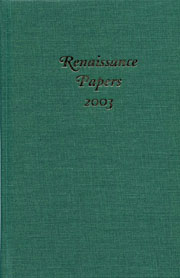Book contents
- Frontmatter
- Contents
- Renaissance Papers
- Homer, Erasmus, and the Problem of Strife
- William Tyndale Among the Demons
- The Printing of “this written book”: G.T. and H.W.'s Editorial Disputes in The Adventures of Master F.J.
- George Puttenham as Comedic Artificer
- Amoret and Scudamour Woo and Wed: Two Courtly Histories and a Stalemate
- Strange Bedfellows: “The Churching of Women” and The Taming of the Shrew
- “Romans, countrymen, and lovers”: Performing Politics, Sovereign Amity and Masculinity in Julius Caesar
- “Rouse Up a Brave Mind”: The Merchant of Venice and Social Uprising in the 1590s
- Revenge Tragedy and Elizabeth Cary's Mariam
- “very worthely sett in printe”: Writing the Virginia Company of London
George Puttenham as Comedic Artificer
Published online by Cambridge University Press: 12 September 2012
- Frontmatter
- Contents
- Renaissance Papers
- Homer, Erasmus, and the Problem of Strife
- William Tyndale Among the Demons
- The Printing of “this written book”: G.T. and H.W.'s Editorial Disputes in The Adventures of Master F.J.
- George Puttenham as Comedic Artificer
- Amoret and Scudamour Woo and Wed: Two Courtly Histories and a Stalemate
- Strange Bedfellows: “The Churching of Women” and The Taming of the Shrew
- “Romans, countrymen, and lovers”: Performing Politics, Sovereign Amity and Masculinity in Julius Caesar
- “Rouse Up a Brave Mind”: The Merchant of Venice and Social Uprising in the 1590s
- Revenge Tragedy and Elizabeth Cary's Mariam
- “very worthely sett in printe”: Writing the Virginia Company of London
Summary
George Puttenham in The Arte of English Poesie marshalls the troops of Lady Rhetoric to instruct the courtier in modes of speech and propriety. By the renaming of traditional rhetorical figures and tropes, he creates a band of personifications who cry out to be identified with types of male courtiers: “the Ringleader” (Prozeugma); “the Ouer reacher, otherwise called the loud lyer” (Hyperbole); and “the right reasoner” (Dialogismus), to name a few. The process of personification of elements of poetry has already begun by Book Two, in which metonymical feet become runners, plodders, or marchers with inconsistent gaits (Arte 81, 83). This band of personifications seems poised to leap from the page to the stage. Although The Arte “can be read as a masque,” as Andrew Hadfield observes, “positioning the monarch as the best reader,” a reader can also imagine a performance of the work as “Poesie Drammatick … put in execution by the feate and dexteritie of mans body,” to borrow Puttenham's own definition (Arte 49). These would-be characters join some comedic characters from lost plays by Puttenham, who, in turn, serve as examples of linguistic and rhetorical devices. What I am interested in exploring is the way the account of his own comedy, Ginecocratia, summarized in The Arte, supports the concerns Puttenham develops more extensively (if often ambivalently or by indirection) in his treatise: the new comedy; the role of women influencing rulers; the status of prophecy, and the rhetorical uses of ambiguity.
- Type
- Chapter
- Information
- Renaissance Papers 2003 , pp. 55 - 70Publisher: Boydell & BrewerPrint publication year: 2004

